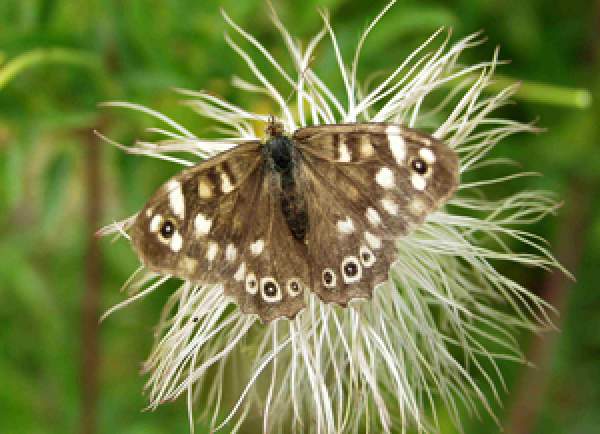Speckled Wood
Pararge aegeria

The chocolate and cream markings of this species are unmistakable, even with the small amount of regional and seasonal variation in the size and background colour of the markings. For example, within a generation, females tend to have larger, more pronounced cream markings than the males. Second generation individuals tend to be darker than those of the first generation. A subspecies found on the Isles of Scilly, has orange-brown rather than cream markings.
Although Speckled Woods can form sizeable colonies in their favoured woodland habitats, they are a mobile species and can be found at much lower densities across a range of other habitats. However, woodland remains important and this may explain the relative lack of Speckled Woods in north Cambridgeshire and Lincolnshire, areas that are climatically suitable but dominated by intensive arable farming. Global climate change is likely to benefit this species within Britain and Ireland but the range will only increase if suitable woodland habitat is also available. The Speckled Wood has undergone a major increase in range and population size over the last thirty years.
Males, because of their behaviour, are more conspicuous than females. In fact, research has shown that males will adopt one of two strategies in order to find a mate. Some individuals are territorial, and a territory-holding male will typically perch on vegetation in a small pool of sunlight, from where he will take flight to intercept any intruder. These territory holding males are predominantly paler in colour than the dark males that engage in the other strategy, that of actively patrolling in search of a mate. It is thought that the darker males are able to warm up more quickly when basking, and so can spend longer in flight.
Early in the year, and again at the end of the year, Speckled Woods can be seen nectaring on flowers. However, for most of the year, they feed on honeydew high in the trees. The eggs are laid singly, in warm sheltered spots and the favoured foodplants include various grasses (e.g. yorkshire fog, cock’s foot and false brome). The green colour of the caterpillars provides suitable camouflage, making them difficult to find as they feed on leaf edges.






Share this page